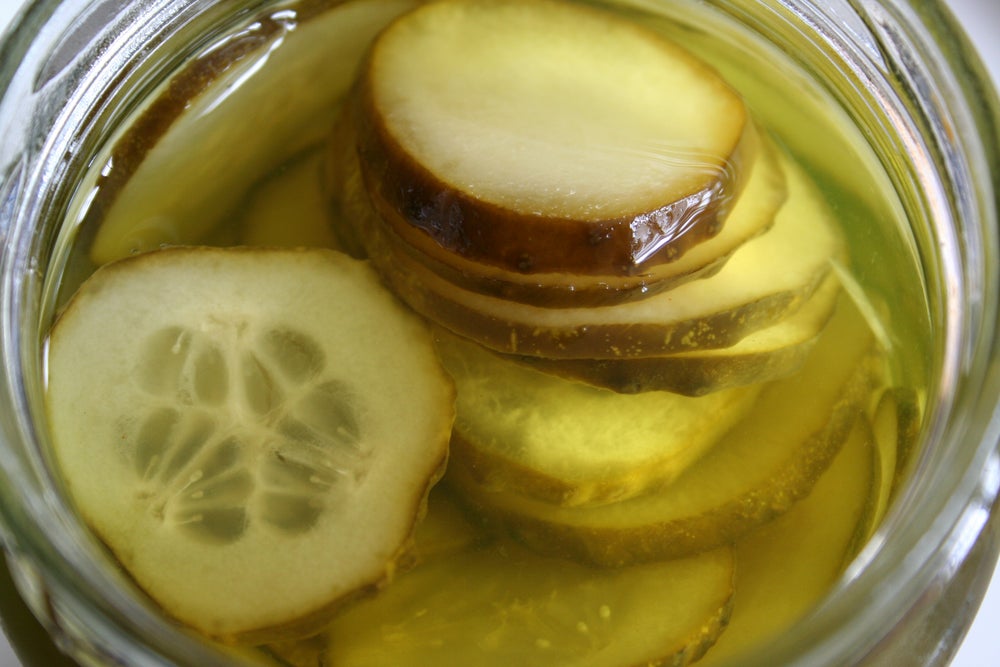Fact Or Fallacy: Pickle Juice As Sports Nutrition

"If someone intends to ingest pickle juice with the goal of increasing blood electrolyte levels, it is an ineffective strategy." Photo: <a href=http://shutterstock.com>Shutterstock.com</a>
A new study looks at a different kind of “green juice” for athletes.
When it comes to getting electrolytes during an Ironman, some athletes skip the salt tablets and hit the juice—pickle juice, that is.
The practice comes from the field of athletic training, where more than 25 percent of athletic trainers say they administer pickle juice to replenish elecrtolytes quickly. This practice, however, is based on supposition, not science.
“It is assumed by many that electrolyte loss causes exercise-associated muscle cramps in athletics,” said Mike McKenney, MS, ATC, NASM-CES, Athletic Trainer at Northeastern University Sports Medicine. “As a result, the prevailing theory was that pickle juice ingestion would acutely restore sodium losses and provide relief for an athlete experiencing a cramp, since pickle juice is very high in sodium. Anecdotally, many claim this practice is effective, but no studies have been able to prove how or if it works. “
Until now. McKenney and his team of researchers recently conducted a study to determine the ability (or lack thereof) of pickle juice to treat exercise-induced cramping. Subjects drank pickle juice while exercising. While exercising at 80-85 percent of maximum heart rate while wearing heavy clothing in a heat chamber, subjects either drank pickle juice right before exercise, before and halfway through, or drank nothing at all. Blood tests were conducted throughout the study to measure electrolyte balance.
The results, published in the January 2015 issue of Journal of Athletic Training, found no differences in plasma sodium concentration, plasma potassium concentration, plasma osmolality, and changes in plasma volume in any condition up to 125 minutes following ingestion.
RELATED: The Dehydration Debate
“That means when subjects drank pickle juice both before and during exercise, it was no different than the when they drank nothing throughout the entire exercise session for up to two hours.” McKenney stated. “This also tells us that if someone intends to ingest pickle juice with the goal of increasing blood electrolyte levels, it is an ineffective strategy.”
This could be, in part, because pickle juice contains a high amount of sodium in a low amount of liquid. McKenney advises athletes, especially those training and racing for long periods of time or in the heat, find the correct balance of both: “A common mistake athletes make is taking in a lot of sodium but not drinking enough fluids to go with it, or sodium is treated as a dietary enemy and removed from the diet as much as possible. Both are required for proper hydration levels, and you have to ingest both to aid in restoring fluid balance. “
So what does work? A combination of water and sports drink. Additionally, the athlete should ingest some sort of carbohydrate and electrolyte-dense food like gels or chews.
“It is important to note that electrolyte replacement cannot occur solely from commercially available sports drinks because they do not contain enough sodium to replace what is lost in sweat. It must come from food.” Said McKenney. “Also, athletes should drink to thirst and take care to not overdrink during a race. Overdrinking fluids has been shown to be a major contributing factor in the onset of hyponatremia. Success during an event will be dictated by proper nutrition and hydration strategies leading up to competition.”